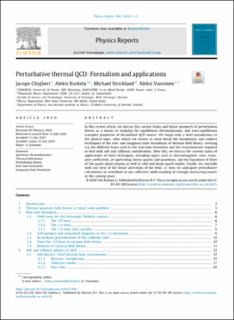| dc.contributor.author | Ghiglieri, Jacopo | |
| dc.contributor.author | Kurkela, Aleksi | |
| dc.contributor.author | Strickland, Michael | |
| dc.contributor.author | Vuorinen, Aleksi | |
| dc.date.accessioned | 2023-01-09T13:50:24Z | |
| dc.date.available | 2023-01-09T13:50:24Z | |
| dc.date.created | 2020-12-02T12:54:03Z | |
| dc.date.issued | 2020 | |
| dc.identifier.citation | Ghiglieri, J., Kurkela, A., Strickland, M., & Vuorinen, A. (2020). Perturbative thermal QCD: formalism and applications. Physics Reports, 880, 1-73. | en_US |
| dc.identifier.issn | 0370-1573 | |
| dc.identifier.uri | https://hdl.handle.net/11250/3042036 | |
| dc.description.abstract | In this review article, we discuss the current status and future prospects of perturbation theory as a means of studying the equilibrium thermodynamic and near-equilibrium transport properties of deconfined QCD matter. We begin with a brief introduction to the general topic, after which we review in some detail the foundations and modern techniques of the real- and imaginary-time formalisms of thermal field theory, covering e.g. the different bases used in the real-time formalism and the resummations required to deal with soft and collinear contributions. After this, we discuss the current status of applications of these techniques, including topics such as electromagnetic rates, transport coefficients, jet quenching, heavy quarks and quarkonia, and the Equations of State of hot quark–gluon plasma as well as cold and dense quark matter. Finally, we conclude with our view of the future directions of the field, i.e. how we anticipate perturbative calculations to contribute to our collective understanding of strongly interacting matter in the coming years. | en_US |
| dc.language.iso | eng | en_US |
| dc.publisher | Elsevier | en_US |
| dc.rights | Navngivelse 4.0 Internasjonal | * |
| dc.rights.uri | http://creativecommons.org/licenses/by/4.0/deed.no | * |
| dc.title | Perturbative thermal QCD: Formalism and applications | en_US |
| dc.type | Peer reviewed | en_US |
| dc.type | Journal article | en_US |
| dc.description.version | publishedVersion | en_US |
| dc.rights.holder | the authors | en_US |
| dc.subject.nsi | VDP::Matematikk og Naturvitenskap: 400 | en_US |
| dc.source.pagenumber | 1-73 | en_US |
| dc.source.volume | 880 | en_US |
| dc.source.journal | Physics reports | en_US |
| dc.identifier.doi | 10.1016/j.physrep.2020.07.004 | |
| dc.identifier.cristin | 1855291 | |
| cristin.ispublished | true | |
| cristin.fulltext | original | |
| cristin.qualitycode | 2 | |

